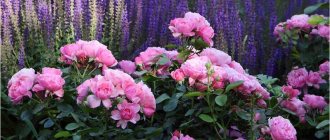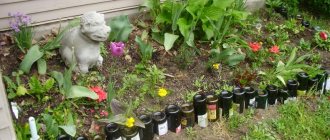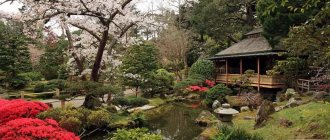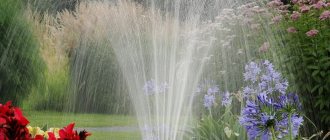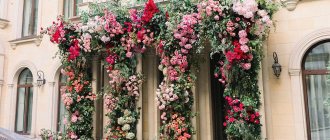Almost every personal plot has a flower garden. It is able to diversify landscape design and add bright colors to it. This can be a central element around which a recreation area, a play area, or a connecting link between the house and colorful plantings will be grouped.
In any case, the design of a flower garden must be taken with full responsibility. Here it is important to choose the right shape of flower beds, choose flowers, and think through the decor. In this article we will look at the advantages of round flower beds, their harmonious location on the site, popular planting schemes, choice of vegetation and much other useful information.
Where to place a round flower bed
A circular flower bed will look best in the front yard, such as the front of the house or the front area. It can also be placed next to the lawn, or directly on it. Then the bright colors of the flowers will become even more saturated and expressive.
Attention : when choosing the location of the flower garden, do not forget to adhere to the design of existing buildings, decor and other plantings. A flowerbed must complete the overall appearance of the landscape and not disrupt it.
When choosing the location of a flower garden, it is important to consider:
- he did not interfere with the passage;
- the flowerbed was visible from all sides;
- the plants had enough sunlight.
As for the size of the flower garden, it is worth starting from the dimensions of the house itself, the site, and personal wishes. If there is little space in front of the house, then a huge flowerbed will only emphasize the lack of free space. And in a large area, a small oasis of flowers will simply get lost.
Design rules
Decorating a flower bed on a site is an interesting and exciting activity. The main thing is to adhere to the following rules:
- take into account the combination of color palette, shape of buds and leaves, and their sizes . The most important thing is to choose the right color combination. It can be a gentle and romantic flowerbed, designed in pastel colors, or bright and contrasting. The dominant colors are: red, pink, yellow and orange. These flowers are given a special place in the flower garden, in the most visible place. And they will be beautifully complemented by plants in purple and blue tones. White, light blue, pale yellow flowers can be planted as a border;
- When choosing vegetation, the requirements for their care . That is, it is important to take into account the type of soil, the intensity of illumination of the area, and the frequency of watering. Some flowers grow well in the shade, while others grow well in the sun. Some plants are watered daily, others once a week;
- take into account the flowering period . Some plants bloom earlier, others later. It is best to place a flowerbed of continuous flowering in front of the house, where some plants bloom to replace others. Thus, there will always be an elegant and ever-blooming flower garden in the yard;
- monitor the planting density . Each plant needs its own personal space. If there are too many flowers, they will grow and develop poorly. And, most likely, they will not please you with abundant and long-lasting flowering. There are no more than 2-3 large plants per square meter. But medium-sized flowers can be used for 1 sq.m. place about 6 pieces, low-growing up to 12 pieces;
- edging _ When designing a round flower bed, it plays an important role. You can make a border from low-growing plants, as well as from stone, brick and other materials.
Attention: when creating a flower garden, pay attention to the height of the plants. Tall flowers are planted in the center, then medium ones, and the border is made of low-growing flowers.
Plant selection
It is important to immediately decide on the range of future plantings. There can be many options. In order not to get confused, they decide whether the set of plants will be perennial or will have to be updated annually. What flowers to plant, each owner of a summer cottage decides independently based on his preferences and capabilities. But it can be difficult for a novice gardener to make a choice, since the name of the flowers may not mean anything to them. In this case, it is better to opt for annuals, since most of them are unpretentious and easy to grow. They have another undeniable advantage: grown from seedlings, they begin flowering early, which usually continues throughout the season. With perennials, continuous flowering is much more difficult to achieve.
How to do it right? It is necessary to draw up a flowering schedule for the future inhabitants of the flower garden.
- Early bloomers: Bulbs and other primroses are the first to greet the season. They will be replaced by subulate phlox, daisies, pansies, dicentra.
- At the end of spring - beginning of summer, lactiferous peonies, bearded irises, Matrona's noctule, oriental poppy, doronicum, brunnera, aquilegia, astilbe, and swimsuit will bloom.
- During most of the summer, various types of bells, lilies, daisies, daylilies, delphiniums, aconites, perennial carnations, centranthus, and yarrows delight the eye.
- In the second half of summer, phloxes, dahlias, gladioli, catnips, monarda, some types of anemones, and eustoma join the floral ensemble, more information about the cultivation of which can be found here.
- At the end of summer and autumn, sedums, perennial asters, rudbeckias, and chrysanthemums will delight you with their flowering.
It is good if the flower garden contains various decorative cereals throughout the season.
A huge selection of plants will allow you to make a round flower bed always blooming. The main criterion when selecting plants is similar requirements for light, water regime, acidity and soil fertility. And the place where the plants will be planted must meet these requirements.
What flowers to plant
The choice of colors depends on the personal wishes of the owners of the site, the overall landscape design, and the style of the house. If we are talking about a huge stone mansion designed in the old English style, it is better to choose roses, lilac peonies, clematis, and conifers.
Important : for this direction, various sculptures made of evergreen plants, surrounded by fountains, are suitable.
If the flower garden is located in the center of the garden, flowers such as roses, lavender, aquilegia, and pansies are chosen here.
When placing a flower bed in front of the house, select phloxes, lilies, bells, asters, carnations, and evergreen begonias.
How to make a round flowerbed at the dacha with your own hands: stages of work
A round flowerbed in front of the house is quite easy to make. The main thing is to plan it correctly and think everything through. To begin with, it is important to decide:
- with a place
- sizes;
- scheme;
- plants;
- color scheme;
- edging.
Site selection
It is best to make a round flowerbed in front of the house. The location is selected in such a way that it is clearly visible from all sides. This could be the central part of the garden, the middle of the lawn, or a recreation area.
Soil preparation
The area for the flower garden must have soil suitable for the planted vegetation. Before planting flowers, it is worth adding fertilizers and complex additives to the soil.
Attention : if plants love fertile soil, you should not plant them on loam. They will grow and develop poorly, and will not please you with abundant flowering.
Filling a flowerbed with flowers
As for choosing colors, you should adhere to the following rules:
- plant height should not be more than 80 cm;
- special attention is paid to the color scheme. Flower beds can be: monochrome (consist of the same color, but different shades), contrasting, with smooth transitions from one color to another, neutral (in such flower beds green shades with dim color touches predominate).
Advice from an experienced gardener
To create a high-quality flowerbed with your own hands from perennials, you should follow some tips that have been put into practice more than once:
- When forming a planting on a site, there is no need to be afraid to create plant compositions that are original in form and execution.
- Medium- and tall-growing perennial plants are perfect for growing in row conditions.
- It is worth choosing plants so that the flowerbed has a wave-like color from early spring to late autumn and is not empty.
- You should definitely pay attention not only to flowering plants, but also to those whose foliage is colored in unusual shades.
- It is necessary to plant several plants of the same variety at once so that when they grow, they create the effect of movement.
- It’s worth playing with contrasts and mixing colors, textures and plant varieties without fear.
Interesting design ideas
Round flower beds can add special originality to landscape design. Summer residents show their imagination by building exclusive flower oases in the middle of the yard:
- flowerbed with a bridge in the middle;
- a fairy-tale carriage surrounded by a bright flower bed;
- women's hat;
- floral watches, which are already becoming classics, but always attract attention;
- a simple flowerbed with graying stump. But it looks quite impressive and aesthetically pleasing;
- flowerbed with living fencing.
As you can see, there are many interesting ideas for creating a flower garden on your site. The main thing is to know exactly what end result you need, choose the right plants, create a clear planting scheme and show your creative thinking. Then your yard will become unique, colorful and unusually beautiful in the warm season.
Types of flower beds: regular
According to the method of planting, flower beds can be regular or irregular. Regular ones are more labor-intensive to set up: plants of approximately the same height are selected for them, always low-growing annuals and ground-cover perennials. It is important to select all species so that their flowering matches. The main feature of regular flower beds is the clarity of the lines, forming a beautiful geometric pattern.
Regular flower beds are rarely created on personal property; their prerogative is city parks and public gardens. This type of flower beds requires constant care, the difficulty of which is that the root system of perennials grows quickly, disrupting the pattern. But, if you have the time and desire to create something special near a private house, you can try.
First, an ornament for the future flower bed is drawn up on a sheet of paper, on which different types of plants are indicated by color. Then the pattern is transferred to an area with prepared soil: the lines of the pattern are drawn using sand. And only after this, plants are planted in a strictly defined order (in accordance with the plan).
Advice. If you decide to make a regular flowerbed on your site, you can use vegetation with foliage of different colors in its design: spotted lariat, creeping clover, trapezoidal sorrel, blood-red heuchera, various varieties of tenacious and saxifrage.

